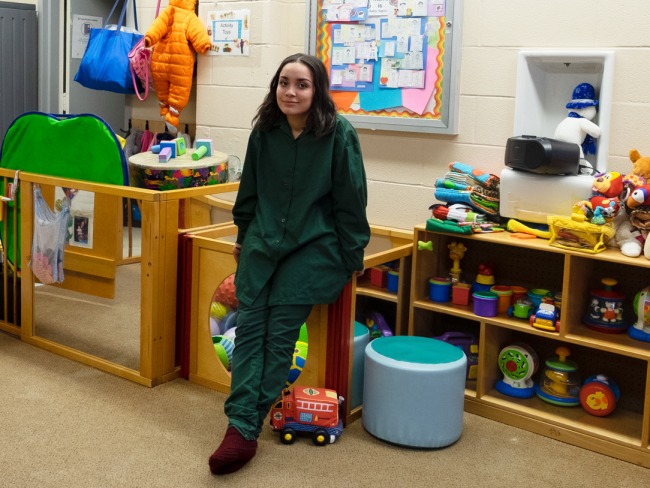Latinx Disparities in Youth Incarceration
Latinx youth are 16% more likely to be incarcerated than their white peers, a sharp improvement over the decade.
Related to: Youth Justice, Racial Justice
For a decade, incarceration disparities between Latinx and white youth have fallen, though disparities still remain. As of 2021, Latinx youth were 16% more likely to be placed (i.e., detained or committed) in juvenile facilities as their white peers, according to nationwide data collected in October 2021 and recently released. These data reveal a sharp decline in Latinx-white youth incarceration disparities since 2011; that year, Latinx youth were 76% more likely to be in placement than white youth.1
Juvenile facilities, including 1,323 detention centers, residential treatment centers, group homes, and youth prisons2 held 24,894 youths as of October 2021. (These data do not include the 291 people under 18 in adult prisons at year-end 20213 or the estimated 2,000 people under 18 in adult jails at midyear 20214.)
Nationally, the youth placement rate was 74 per 100,000 youth in 2021. The Latinx youth placement rate was 57 per 100,000, compared to the white youth placement rate of 49 per 100,000.
A total of 20% of youths in placement are Latinx, and Latinx youth comprise 25% of all youth across the United States.5 Latinx youth are more likely to be in custody than white youth in half of states with at least 8,000 Latinx youth (between the ages of 10 and 17), a cutoff that allows for meaningful comparisons
Between 2011 and 2021, juvenile placements fell by 59%. During these years, Latinx youth placements declined slightly faster than white youth placements (a 65% decline vs. 57%), resulting in a smaller but still considerable disparity.
Between 2011 and 2021, ethnic disparities grew by more than 10% in states and decreased by at least 10% in 25 states.
- As of 2021, in Massachusetts, New Jersey, and Connecticut, Latinx youth are at least 4 times as likely to be held in placement as are white youth.
- Between 2011 and 2021, Kansas and New Jersey saw their Latinx/white disparity increase by at least 50%.
- During these same years, Pennsylvania, Florida, Minnesota, Rhode Island, New Mexico, Delaware, Hawaii, and New Hampshire decreased their disparities by at least half.
| State | Latinx Rate | White Rate | L/W Racial Disparity |
|---|---|---|---|
| Alabama | 78 | 97 | 0.80 |
| Arizona | 31 | 41 | 0.76 |
| Arkansas | 56 | 66 | 0.85 |
| California | 67 | 32 | 2.09 |
| Colorado | 87 | 49 | 1.78 |
| Connecticut | 13 | 3 | 4.33 |
| Delaware | 0 | 52 | N/A |
| Florida | 5 | 52 | 0.10 |
| Georgia | 28 | 33 | 0.85 |
| Hawaii | 0 | 18 | N/A |
| Idaho | 151 | 99 | 1.53 |
| Illinois | 18 | 14 | 1.29 |
| Indiana | 70 | 93 | 0.75 |
| Iowa | 73 | 51 | 1.43 |
| Kansas | 160 | 63 | 2.54 |
| Kentucky | 48 | 33 | 1.45 |
| Louisiana | 36 | 55 | 0.65 |
| Maryland | 15 | 9 | 1.67 |
| Massachusetts | 65 | 10 | 6.50 |
| Michigan | 53 | 50 | 1.06 |
| Minnesota | 26 | 33 | 0.79 |
| Mississippi | 26 | 33 | 0.79 |
| Missouri | 81 | 71 | 1.14 |
| Nebraska | 106 | 51 | 2.08 |
| Nevada | 83 | 76 | 1.09 |
| New Hampshire | 0 | 9 | N/A |
| New Jersey | 34 | 7 | 4.86 |
| New Mexico | 37 | 193 | 0.19 |
| New York | 28 | 18 | 1.56 |
| North Carolina | 20 | 16 | 1.25 |
| Ohio | 67 | 63 | 1.06 |
| Oklahoma | 34 | 46 | 0.74 |
| Oregon | 147 | 127 | 1.16 |
| Pennsylvania | 69 | 49 | 1.41 |
| Rhode Island | 48 | 63 | 0.76 |
| South Carolina | 46 | 54 | 0.85 |
| Tennessee | 13 | 24 | 0.54 |
| Texas | 77 | 60 | 1.28 |
| Utah | 83 | 23 | 3.61 |
| Virginia | 51 | 30 | 1.70 |
| Washington | 63 | 35 | 1.80 |
| Wisconsin | 53 | 34 | 1.56 |
| Wyoming | 161 | 224 | 0.72 |
| U.S. Total | 57 | 49 | 1.16 |
The table above and the figure below are limited to the 43 states with at least 8,000 Latinx residents between 10- and 17-years old. Numbers in the third column reveal the extent to which Latinx youth are more likely to be incarcerated than white youth. For example, in Alabama, Latinx youth are .80 times as likely (e.g., less likely) to be held in a juvenile facility than their white peers. States listed as N/A had no Latinx youth in placement as of the 2021 one-day count.
Change in Latinx/White Placement Disparity; 2011 vs. 2021
Positive numbers reveal an increase in the ethnic disparity between 2011 and 2021, and negative numbers reveal a decreased ethnic disparity. States listed as “-100%” had no Latinx youth in placement as of the 2021 one-day count.

| 1. | Puzzanchera, C., Sladky, T.J., and Kang, W. (2023). “Easy Access to the Census of Juveniles in Residential Placement.” Available: https://www.ojjdp.gov/ojstatbb/ezacjrp/ |
|---|---|
| 2. | Puzzanchera, C., Hockenberry, S., Sladky, T.J., and Kang, W. (2022). “Juvenile Residential Facility Census Databook.” Available: https://www.ojjdp.gov/ojstatbb/jrfcdb/ |
| 3. | Carson, E. A. (2022). Prisoners in 2021-Statistical Tables. Bureau of Justice Statistics. https://bjs.ojp.gov/sites/g/files/xyckuh236/files/media/document/p21st.pdf |
| 4. | Zeng, Z. (2022). Jail Inmates in 2021 – Statistical Tables. https://bjs.ojp.gov/sites/g/files/xyckuh236/files/media/document/p21st.pdf |
| 5. | Puzzanchera, C., Sladky, A. and Kang, W. (2021). “Easy Access to Juvenile Populations: 1990-2020.” Online. Available: https://www.ojjdp.gov/ojstatbb/ezapop |



